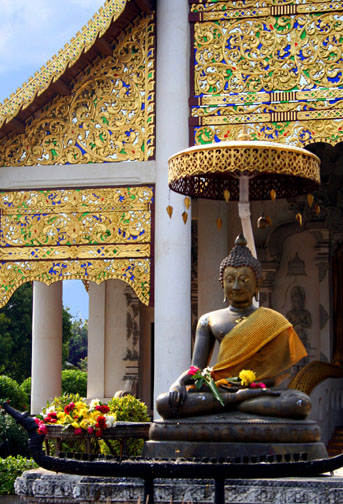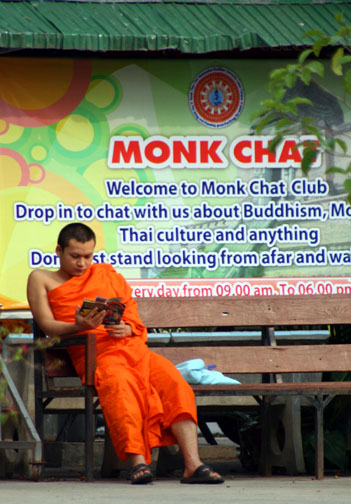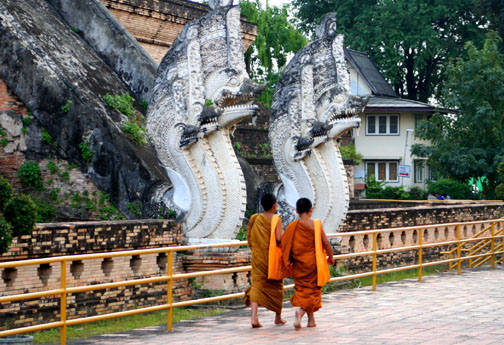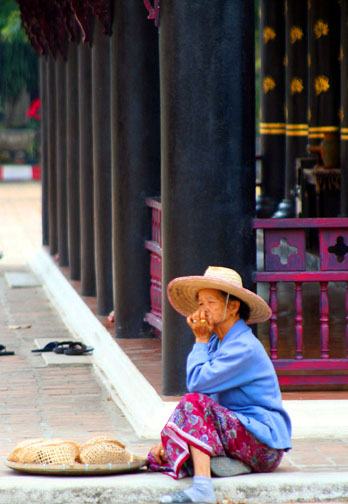Tags
It’s not that I didn’t know about Wat Chedi Luang in Chiang Mai. It gets good press in all the guide books. But its claim to fame: its brickwork stupa, partially destroyed by an earthquake a few hundred years after its construction – though one source claims the damage was from King Taksin’s cannons firing on the city to chase out the Burmese in the 18th (guess which story I prefer) – is not awe inspiring. It’s not like a large pile of ancient rubble is an unheard of sight in Chiang Mai. Even at a wat. A crumbling stupa has just never been enough to stir my curiosity.
It’s not that I didn’t know where Wat Chedi Luang was either. In fact, I’d been just inside the compound’s entrance during more than one Sunday Night Market. But it’s neighbor, Wat Phan Tao, with its teak wood wiharn was of far more interest. And really, which sounds more enticing: Temple of the Big Stupa or The Monastery of a Thousand Kilns? Yup, another reason my normal route directed me to Wat Phan Tao instead.
During one visit during market night I stumbled upon a large gathering of novice monks there all kneeling and chanting in unison, the large teak wood temple reverberating with their call. An incredible sight and a photo op extraordinaire. During the Yi Peng celebration, the monks filled the wat’s large open courtyard with hundreds of flames burning at ground level in small clay bowls mimicking a fleet of krathongs floating down the Ping River while the celebration’s khom loi lanterns sailed through the night’s sky. Wat Chedi Luang’s offering was its normal spot lit Buddha perched as a focal point for its circular driveway in front of the temple. From what I had seen of the wat, it was yet another of the ‘white wat/red tile roof’ school of Thai temples, reminiscent of a few hundred similarly built wats throughout the Kingdom. A bit mundane, too commonplace to draw me in.
But on a long visit to Chiang Mai with days busily filled doing nothing I decided to take a walk up to the wat and poke around. At worse I’d get a photo of another crumbling pile of bricks. The visit turned out to be much more enjoyable than I’d expected and I returned again the next day to spend more time there.
I started my tour at the wiharn, a fairly recent part of the wat built in 1928. It has a rather imposing standing Buddha inside surrounded by large black columns intricately decorated with gold leafed designs. The pillar’s lotus shaped finials set off the temple’s red ceiling while the gold leaf shimmered, lit by a series of crystal chandeliers. It’s a rather dramatic interior, the window shutters display the same black and gold color scheme. In retrospect, the wiharn alone was worth visiting the wat. But then there’s the stupa.
The 270 foot tall brick chedi behind the temple is a massive edifice flanked on all four sides by gigantic staircases replete with naga balustrades. It’s no longer crumbling. In the early 90s it was reconstructed and today is the highest structure allowed to be built within the old city. It dominates the rear courtyard of the wat, casting its shadow on an urban park like setting that includes several small chapels and a black and plum colored building that houses a reclining Buddha statute.
At the top of the chedi are four Buddha statutes, each taking a position of the four points of the compass. The one sitting in the eastern niche is a reproduction of the Emerald Buddha, the original of which once occupied that spot before being moved to Luang Prabang and finally to Bangkok where it now sits in a place of honor at the Temple of the Emerald Buddha on the grounds of the Grand Palace.
The promenade surrounding the chedi is a nice place to sit and watch the novice monks make their way to classrooms; a series of benches under shady tress make it an inviting place to stop and rest a while. Signs asking touri not to pay vendors selling caged birds to set free far out number the lonely old woman actually selling the birds.
The same black and plum colored structure that houses the Reclining Buddha also is home to a big, fat, Sangkhachai Buddha, similar in style to the ‘Happy Buddha’ you often see in China. Phra Sangkadchai was a notable Thai monk. One tale says that he was so handsome that once even a man wanted him for a wife. To avoid a similar situation from happening again, Phra Sangkadchai decided to transform himself into a monk with an unpleasantly fat body. Evidently he’d never heard of chubby chasers.
The nearby chapels are dedicated to specific monks and hold life-size statues of them inside. Though smaller in size and stature than the main temple, each is finely detailed and worth kicking off your shoes so that you can go inside.
But before you get to the chedi and the smaller temples, to the right of the wiharn is a shady courtyard filled with stone tables and benches where the monastery holds its daily monk chat sessions (from 9am – 6 pm in case you are planning a visit). As magnificent as the pagoda was, the chance to sit down and talk with a monk was an opportunity too enticing to pass up. They’re quite welcoming and large signs designating the monk chat area implore: Do not stand looking from afar and walk away! With an invitation like that, how could I resist?
The monks available to talk with are novices. I’m sure part of the program is to entice donations from visitors; a larger part is to provide the novice monks a chance to practice their foreign language skills. The wat is home to the Lanna campus of the Mahamakut Buddhist University, so the compound is crawling with young monks. I assumed these guys are normally peppered with questions about Buddhism and the monkhood, so after being assigned a young monk and taking a seat in the shade I started our chat with a flippant question, “Seen any good movies lately?”
I’d expected maybe a laugh before we launched into a religious discussion, but Wit, my monk for the day, had just seen Avatar and was enthralled with the movie. So Wit and I spent over and hour chatting about the Avatar experience. Service as a monk aside, he turned out to be a typical teenager, really not all that different from teens back home. Though his English was a bit better.
I don’t know if the latest science fiction blockbuster is an approved subject for the Monk Chat program, but Wit had a great time discussing the movie and probably had one of his more enjoyable monk chat sessions. I returned again the next day, armed with some photos, to ask a few questions that had been plaguing me about Buddhism. Although I didn’t expect to get to talk with Wit again, when I walked up to the area I heard a delighted cry of “Avatar” come sailing out of the shadows, quickly followed by Wit in his saffron robes.
Buddhist beliefs and religious practices were not my main interest for our second chat session. Matters of a more practical nature were. What I really wanted to know was what the various color of robes monks wear signify. Different status? Various sects? Perhaps job duties? Day of the week? I’d brought several of my ‘Monk Shot!’ photos to use rather than getting lost in translation of the different colors I’ve seen monks wearing and showed Wit two of them. The first was of a monk in the standard saffron robe, the second of a monk from a visit to Doi Suthep wearing a gold color robe of a heavier woven cloth. Showing the first photo, I pointed at Wit and said, “Like you.” Showing the second, I laid my finger against the gold robe and asked, “Why he wear this color?
Wit thought about it for a minute, then answered, “He cold.”
Guess there was my answer. The other shots went back into my bag and we returned to a more weighty topic: round two on Avatar.
The made up language used by the aliens in the movie must have some kinship with the Thai language. While Wit often stumbled over English words, he spoke the language of the Na’vi like a native. During our chat the previous day he’d talked about his favorite scenes. This time he tried explaining how the way the aliens in the movie lived their life coincided with the way of Buddha and the path to enlightenment.
Wit started with the small floating white blossoms, the ‘Atokirina’, using his fingers to mimic their graceful floating through the air. Once he was sure I was with him, he proclaimed, “Buddha.” Then again using pantomime he demonstrated the joining of the Na’vi’s braided hair with the ‘Pa’li’ and ‘Ikran’ (that’d be the horse thingies and flying bird creatures for those of you who do not speak the language of Pandora). And again Wit nodded and said, “Buddha.” Warming to his subject, he pointed to nearby trees, bushes, and flowers, and then made an all encompassing gesture identifying his meaning with “Eywa” and again nodded and smiled, “Buddha!”
When Wit got to the major battle sequences and started making large exploding sounds, whether he was about to add another point to his claim of the movie’s Buddhist leanings or not, a stern look from a older mink supervising the novices quickly quieted him down.
His attempt at Buddhist instruction was infectious, as was his enjoyment of the opportunity to talk about his favorite movie. I smiled and nodded a lot, encouraging him to go on though my memory of the movie was not as detailed as his. But when I got back to my hotel I turned to Google to make some sense of what Wit had been trying to communicate to me, and there certainly was a religious theme of expressing a harmony with nature in the movie. Like Buddha is to Thais, in the movie, Eywa is the guiding force and deity of the Na’vi. Buddha teaches that to reach a state of enlightenment, you must perceive the fundamental mystic truth that is inherent in all living things. This too was the philosophy of the Na’vi, expressed in how they bonded with the flora and fauna of their world.
It was a shame Wit was unable to give me his take on the movie’s ending, thanks to the dour old monk keeping an eye on him. Afterward, I considered how different our two cultures are. In Thailand, a teenager see a science fiction movie like Avatar and relates it to the teachings of his religion. In America a teenager sees a movie like Avatar and is pissed he’s too old to get one of the movie related toys in a McDonald’s Happy Meal.
Related Posts You Might Enjoy:











Wit has a sexy build & appears composed. An interesting account.